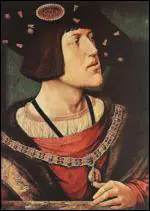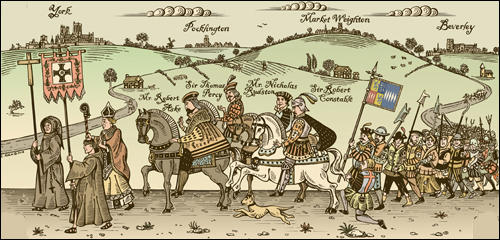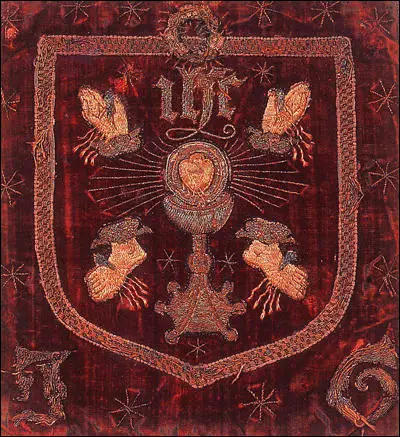Thomas Darcy

Thomas Darcy, the son of Sir William Darcy and Euphemia Langton Darcy, was born in about 1467. His father was a large landowner in the West Riding of Yorkshire. His main home was Templehurst near Leeds.
According to his biographer, Richard Hoyle, Darcy's early reputation appears to have rested on his soldiering skills. He was knighted in 1489. In 1492 he was bound by indenture to serve Henry VII abroad with 1,000 men during the Brittany campaign. In 1497 he saw service on the Scottish borders when he marched with Thomas Howard, Earl of Surrey, to raise the siege of Norham, Northumberland, and pursued James IV into Scotland and he was rewarded with the title of knight-banneret. In November 1498, he was granted the stewardship and constableship of Bamburgh Castle in Northumberland. (1)
Thomas Darcy also served Henry VIII and eventually became the supervisor of all the royal castles in Yorkshire. There is evidence that he sent several letters to the King complaining about the power of Cardinal Thomas Wolsey. It has been claimed that Darcy "was not a tremendously wealthy man, though he was a powerful figure in his part of the world". (2) In the autumn of 1533 Darcy sought from Henry a pardon for a debt of £660 for which he was in danger of being outlawed. (3)
Although a Roman Catholic he remained a loyal follower of the king during his conflict with Pope Clement VII. However, he upset Henry by speaking in Parliament against the proposal to divorce of Catherine of Aragon. "The King forbade him to leave London for another five years, which was perhaps the worst thing he could have done, for it gave Darcy a long time to brood on injustice and to resent his enforced absence from home." (4)
Thomas Darcy & Robert Aske
In September 1536, groups of men began demonstrating against the dissolution of the monasteries. A lawyer, Robert Aske, eventually became leader of the rebellion in Yorkshire. People joined what became known as the Pilgrimage of Grace for a variety of different reasons. Derek Wilson, the author of A Tudor Tapestry: Men, Women & Society in Reformation England (1972) has argued: "It would be incorrect to view the rebellion in Yorkshire, the so-called Pilgrimage of Grace, as purely and simply an upsurge of militant piety on behalf of the old religion. Unpopular taxes, local and regional grievances, poor harvests as well as the attack on the monasteries and the Reformation legislation all contributed to the creation of a tense atmosphere in many parts of the country". (5)
On 6th October, Thomas Darcy wrote to Henry VIII giving details of the uprising in his area. He told the King he did not have enough soldiers to resist the rebels and he would have to retire to Pontefract Castle. "Henry wrote to Darcy that he was surprised that he could do nothing more effective against the rebels, but assured him that he had no doubts as to his loyalty. Privately, Henry told his counsellors that he suspected that Darcy was a traitor." (6) Darcy realized he was outnumbered and thought it better to pacify the rebels rather than take them on in battle. Another reason for his defeatist views, according to Geoffrey Moorhouse, was his poor health: "He was now sixty-nine years old, suffering from a rupture he had incurred in one of Henry's French adventures and from a chronic bowel disorder, which may be why his humour has been described as grim." (7)
Robert Aske arrived at the castle on 20th October. After a short siege, Darcy, running short of supplies, surrendered the castle. Richard Hoyle has pointed out: "Darcy's actions are in fact perfectly plausible when taken at face value and especially when the Pilgrimage of Grace is seen as a widespread popular movement in opposition to expected and feared religious innovations. When disturbances broke out in Yorkshire, he sent the king a long and accurate assessment of the situation and sought reinforcements, money, supplies of munitions, and the authority to mobilize. On two further occasions he wrote at length describing a deteriorating situation. On all three occasions his information and advice were ignored... It was Aske's contention that Darcy could not have resisted a siege, but would have been killed if the commons had stormed the castle." (8)
Edward Lee, Archbishop of York, was sheltering in the castle. He had a reputation as a conservative and in the autumn of 1535 had written to Thomas Cromwell, complaining about the new radical preachers who were active in the region. He followed this up six months later with the suggestion that nobody should be allowed to preach unless they had been granted permission from Henry VIII. Lee had also complained about the plan to close Hexham Abbey. (9) Aske and his followers assumed that the archbishop sympathized with their aims for the restoration of the church's liberties and when he took the pilgrims' oath he was allowed to go free. (10)

After discussions with Robert Aske, Thomas Darcy decided to join the Pilgrimage of Grace. He swore the oath presented to him by Aske. It included the following: "Ye shall not enter into this our Pilgrimage of Grace for the Commonwealth, but only for the love that ye do bear unto Almighty God, his faith, and to Holy Church militant and the maintenance thereof, to the preservation of the King's person and his issue, to the purifying of the nobility, and to expulse all villein blood and evil councillors against the commonwealth from his Grace and his Privy Council of the same. And ye shall not enter into our said Pilgrimage for no particular profit to your self, nor to do any displeasure to any private person, but by counsel of the commonwealth, nor slay nor murder for no envy, but in your hearts put away all fear and dread, and take afore you the Cross of Christ, and in your hearts His faith, the Resititution of the Church, the suppression of these Heretics and their opinions, by all the holy contents of this book." (11)
The oath made it clear that the rebels were loyal to Henry VIII and blamed the closing of the monasteries on the king's officials such as Vicar-General Thomas Cromwell, Archbishop Thomas Cranmer, Bishop Hugh Latimer, Bishop Nicholas Ridley, Bishop Nicholas Shaxton, Lord Chancellor Thomas Audley and Solicitor-General Richard Rich. To followers of the Pilgrimage of Grace, these men were heretics and deserved to be burnt at the stake.
Pilgrimage of Grace
Robert Aske offered the leadership of the Pilgrimage of Grace to Thomas Darcy. He refused but agreed to provide soldiers for the cause. To show his commitment to the new allegiance, one of his first acts was to send the oath that he signed into Lancashire. He also arranged for flags to be made that included the religious insignia of the Five Wounds of Christ (it depicted a bleeding heart above a chalice, both being surrounded at the corners by the pierced hands and feet).

Henry VIII summoned Thomas Howard, 3rd Duke of Norfolk, out of retirement. Norfolk, although he was 63, was the country's best soldier. Norfolk was also the leading Roman Catholic and a strong opponent of Thomas Cromwell and it was hoped that he was a man who the rebels would trust. Norfolk was able to raise a large army but he had doubts about their reliability and suggested to the King that he should negotiate with Aske. (12)
Norfolk had a meeting with Thomas Darcy and tried to persuade him and the other Yorkshire nobles and gentlemen to regain the King's favour by handing over Aske. However, they refused and Norfolk returned to London and suggested to Henry that the best strategy was to offer a pardon to all the northern rebels. When the rebel army had dispersed the King could arrange for its leaders to be punished. Henry eventually took this advice and on 7th December, 1536, he granted a pardon to everyone north of Doncaster who had taken part in the rebellion. Henry also invited Aske to London to discuss the grievances of the people of Yorkshire. (13)
Robert Aske spent the Christmas holiday with Henry at Greenwich Palace. When they first met Henry told Aske: "Be you welcome, my good Aske; it is my wish that here, before my council, you ask what you desire and I will grant it." Aske replied: "Sir, your majesty allows yourself to be governed by a tyrant named Cromwell. Everyone knows that if it had not been for him the 7,000 poor priests I have in my company would not be ruined wanderers as they are now." Henry gave the impression that he agreed with Aske about Thomas Cromwell and asked him to prepare a history of the previous few months. To show his support he gave him a jacket of crimson silk. (14)
While in London another rebellion broke out in the East Riding. It was led by Sir Francis Bigod who accused Darcy and Aske of betraying the Pilgrimage of Grace. Darcy spoke out against this new rising, and his soldiers joined up with Thomas Howard, 3rd Duke of Norfolk, and his army made up of 4,000 men. Bigod was easily defeated and after being captured on 10th February, 1537, was imprisoned in Carlisle Castle. (15)
Arrest and Execution
On 24th March, Thomas Darcy and Robert Aske were asked by the Duke of Norfolk to return to London in order to have a meeting with Henry VIII. They were told that the King wanted to thank them for helping to put down the Bigod rebellion. On their arrival they were both arrested and sent to the Tower of London. (16) Both men were charged with renewed conspiracy after the pardon. (17)
Thomas Darcy was tried in Westminster Hall. During his trial he accused Thomas Cromwell of being responsible for the Pilgrimage of Grace: "Cromwell it is thou that art the very original and chief causer of this rebellion and mischief, and art likewise causer of the apprehension of us that be noble men and dost daily earnestly travail to bring us to our end and to strike off our heads." (18)
Despite his spirited defence he was found guilty of treason on 15th May. Henry VIII wanted Thomas Darcy to be executed in Doncaster. However, Thomas Howard, 3rd Duke of Norfolk, told the King that as Darcy was a popular figure in the area this act might start another uprising. Henry was persuaded to have Darcy executed at Tower Hill instead. This was carried out on 30th June 1537 and Darcy's head was displayed on London Bridge. (19) Darcy's biographer, Richard Hoyle, has pointed out: "It was later claimed that Darcy had been found guilty only because Sir Thomas Cromwell, principal secretary, led the peers trying him and persuaded them to believe that he would be pardoned by the king." (20)
Primary Sources
(1) Richard Hoyle, Thomas Darcy : Oxford Dictionary of National Biography (2004-2014)
Given his vocal opposition to the early Reformation and his withdrawal to Temple Hirst, it is all too easy to assume that the Pilgrimage of Grace was the rebellion of which Darcy had talked with Chapuys in 1534–5. The existence of a muster-book of his forces thought (erroneously) to date from 1 October 1536, his willing surrender of Pontefract Castle, West Riding, to Robert Aske, his emergence as one of the captains of the pilgrims who negotiated with Norfolk, and his refusal to defect to the duke when challenged to do so all point to Darcy's complicity. His claims to have been loyal throughout have been long read as being disingenuous.
Darcy's actions are in fact perfectly plausible when taken at face value and especially when the Pilgrimage of Grace is seen as a widespread popular movement in opposition to expected and feared religious innovations. When disturbances broke out in Yorkshire, he sent the king a long and accurate assessment of the situation and sought reinforcements, money, supplies of munitions, and the authority to mobilize. On two further occasions he wrote at length describing a deteriorating situation. On all three occasions his information and advice were ignored. At the outbreak of trouble he moved to Pontefract Castle, which became a refuge for Thomas Lee, archbishop of York, and other refugee gentry, and made it an irresistible prize for Aske. The muster-book actually shows the complete breakdown of Darcy's ability to recruit troops. Pontefract was blockaded and lacked supplies; the garrison was held to favour the commons. While Darcy hoped to be rescued by George Talbot, fourth earl of Shrewsbury, the latter told Darcy by letter of 17 October that he had been told to hold his position at Newark, Nottinghamshire. After Aske came to Pontefract, Darcy sought a truce, but the situation was judged hopeless and the castle was surrendered on 20 October. It was Aske's contention that Darcy could not have resisted a siege, but would have been killed if the commons had stormed the castle.
Student Activities
Henry VIII (Answer Commentary)
Henry VII: A Wise or Wicked Ruler? (Answer Commentary)
Henry VIII: Catherine of Aragon or Anne Boleyn?
Was Henry VIII's son, Henry FitzRoy, murdered?
Hans Holbein and Henry VIII (Answer Commentary)
The Marriage of Prince Arthur and Catherine of Aragon (Answer Commentary)
Henry VIII and Anne of Cleves (Answer Commentary)
Was Queen Catherine Howard guilty of treason? (Answer Commentary)
Anne Boleyn - Religious Reformer (Answer Commentary)
Did Anne Boleyn have six fingers on her right hand? A Study in Catholic Propaganda (Answer Commentary)
Why were women hostile to Henry VIII's marriage to Anne Boleyn? (Answer Commentary)
Catherine Parr and Women's Rights (Answer Commentary)
Women, Politics and Henry VIII (Answer Commentary)
Historians and Novelists on Thomas Cromwell (Answer Commentary)
Martin Luther and Thomas Müntzer (Answer Commentary)
Martin Luther and Hitler's Anti-Semitism (Answer Commentary)
Martin Luther and the Reformation (Answer Commentary)
Mary Tudor and Heretics (Answer Commentary)
Joan Bocher - Anabaptist (Answer Commentary)
Anne Askew – Burnt at the Stake (Answer Commentary)
Elizabeth Barton and Henry VIII (Answer Commentary)
Execution of Margaret Cheyney (Answer Commentary)
Robert Aske (Answer Commentary)
Dissolution of the Monasteries (Answer Commentary)
Pilgrimage of Grace (Answer Commentary)
Poverty in Tudor England (Answer Commentary)
Why did Queen Elizabeth not get married? (Answer Commentary)
Francis Walsingham - Codes & Codebreaking (Answer Commentary)
Sir Thomas More: Saint or Sinner? (Answer Commentary)
Hans Holbein's Art and Religious Propaganda (Answer Commentary)
1517 May Day Riots: How do historians know what happened? (Answer Commentary)
